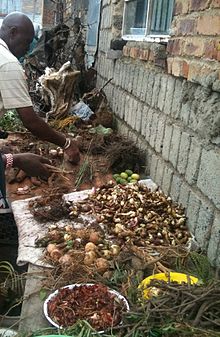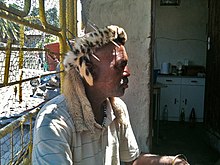
Traditional healers of Southern Africa are practitioners of traditional African medicine in Southern Africa. They fulfil different social and political roles in the community like divination, healing physical, emotional, and spiritual illnesses, directing birth or death rituals, finding lost cattle, protecting warriors, counteracting witchcraft and narrating the history, cosmology, and concepts of their tradition.

Herbal medicine is the study of pharmacognosy and the use of medicinal plants, which are a basis of traditional medicine. With worldwide research into pharmacology, some herbal medicines have been translated into modern remedies, such as the anti-malarial group of drugs called artemisinin isolated from Artemisia annua, a herb that was known in Chinese medicine to treat fever. There is limited scientific evidence for the safety and efficacy of many plants used in 21st-century herbalism, which generally does not provide standards for purity or dosage. The scope of herbal medicine sometimes includes fungal and bee products, as well as minerals, shells and certain animal parts.

Traditional medicine comprises medical aspects of traditional knowledge that developed over generations within the folk beliefs of various societies, including indigenous peoples, before the era of modern medicine. The World Health Organization (WHO) defines traditional medicine as "the sum total of the knowledge, skills, and practices based on the theories, beliefs, and experiences indigenous to different cultures, whether explicable or not, used in the maintenance of health as well as in the prevention, diagnosis, improvement and treatment of physical and mental illness". Traditional medicine is often contrasted with Evidence based medicine.

Medicinal plants, also called medicinal herbs, have been discovered and used in traditional medicine practices since prehistoric times. Plants synthesize hundreds of chemical compounds for various functions, including defense and protection against insects, fungi, diseases, and herbivorous mammals.

Traditional Korean medicine refers to the forms of traditional medicine practiced in Korea.

The sociology of health and illness, sociology of health and wellness, or health sociology examines the interaction between society and health. As a field of study it is interested in all aspects of life, including contemporary as well as historical influences, that impact and alter our health and wellbeing.

Vusamazulu Credo Mutwa was a Zulu sangoma from South Africa. He was known as an author of books that draw upon African mythology, traditional Zulu folklore, extraterrestrial encounters and his own personal encounters. His last work was a graphic novel called the Tree of Life Trilogy based on his writings of his most famous book, Indaba my Children. In 2018 he was honoured with an USIBA award presented by the South African Department of Arts and Culture, for his work in indigenous wisdom.
Ethnomedicine is a study or comparison of the traditional medicine based on bioactive compounds in plants and animals and practiced by various ethnic groups, especially those with little access to western medicines, e.g., indigenous peoples. The word ethnomedicine is sometimes used as a synonym for traditional medicine.
Bush medicine comprises traditional medicines used by Indigenous Australians, being Aboriginal and Torres Strait Islander people. Indigenous people have been using various components of native Australian flora and some fauna as medicine for thousands of years, and a minority turn to healers in their communities for medications aimed at providing physical and spiritual healing.
Yorùbá medicine, or egbòogi, is a Yoruba system of herbalism practiced primarily in West Africa and the Caribbean.

In herbal medicine, a herbal tonic is used to help restore, tone and invigorate systems in the body or to promote general health and well-being. A herbal tonic is a solution or other preparation made from a specially selected assortment of plants known as herbs. They are steeped in water and drunk either hot or cool. Herbal tonics are believed to have healing properties ranging from relieving muscle and joint pain and extend as far as inhibiting some cancers.
This article is about traditional Hausa medicine practised by the Hausa people of West Africa. Hausa medicine is heavily characterized by Islamic influence and traditional, African-style herbology, and religious practices which are still prevalent today. Many traditional healing methods such as religious and spiritual healing are often used alongside modern medicine among Hausa villages and cities.
Celestino Obua is a Ugandan physician, pharmacologist, academic and academic administrator. He is the current Vice Chancellor of Mbarara University of Science and Technology. He assumed that position on Friday, 24 October 2014. Prior to that, he served as the Deputy Principal of Makerere University College of Health Sciences.
Treatment as prevention (TasP) is a concept in public health that promotes treatment as a way to prevent and reduce the likelihood of HIV illness, death and transmission from an infected individual to others. Expanding access to earlier HIV diagnosis and treatment as a means to address the global epidemic by preventing illness, death and transmission was first proposed in 2000 by Garnett et al. The term is often used to talk about treating people that are currently living with human immunodeficiency virus (HIV) and acquired immune deficiency syndrome (AIDS) to prevent illness, death and transmission. Although some experts narrow this to only include preventing infections, treatment prevents illnesses such as tuberculosis and has been shown to prevent death. In relation to HIV, antiretroviral therapy (ART) is a three or more drug combination therapy that is used to decrease the viral load, or the measured amount of virus, in an infected individual. Such medications are used as a preventative for infected individuals to not only spread the HIV virus to their negative partners but also improve their current health to increase their lifespans. When taken correctly, ART is able to diminish the presence of the HIV virus in the bodily fluids of an infected person to a level of undetectability. Consistent adherence to an ARV regimen, monitoring, and testing are essential for continued confirmed viral suppression. Treatment as prevention rose to great prominence in 2011, as part of the HPTN 052 study, which shed light on the benefits of early treatment for HIV positive individuals.
Within the Pacific, Tonga is recognised to have some of the highest overall health standards, implementing a combination of preventative and immediate strategies to curb rates of communicable disease, child mortality and overall life expectancy. The Tongan government aims to continue such levels of health through achieving their Millennium Development Goals (MDG) detailing their focus on improving their healthcare system within the areas of maternal and infant health as well as improve access to immunisation, safe water and sanitation.
Professor Paul Waako, is a Ugandan pharmacologist, academic and academic administrator, who serves as the Vice Chancellor of Busitema University, a public university in the Eastern Region of Uganda, since 1 May 2019.

Diane Havlir is an American physician who is a Professor of Medicine and Chief of the HIV/AIDS Division at the University of California, San Francisco. Her research considers novel therapeutic strategies to improve the lives of people with HIV and to support public health initiatives in East Africa. She was elected to the National Academy of Medicine in 2019.
Traditional and Modern Health Practitioners Together against AIDS(THETA) is a non-government organization in Uganda that promotes collaboration between traditional healers and biomedical practitioners to prevent the spread of HIV/AIDS and provide care for HIV-positive patients. It was seen to be the first significant effort in Africa to involve traditional healers in the efforts against HIV/AIDS.


























